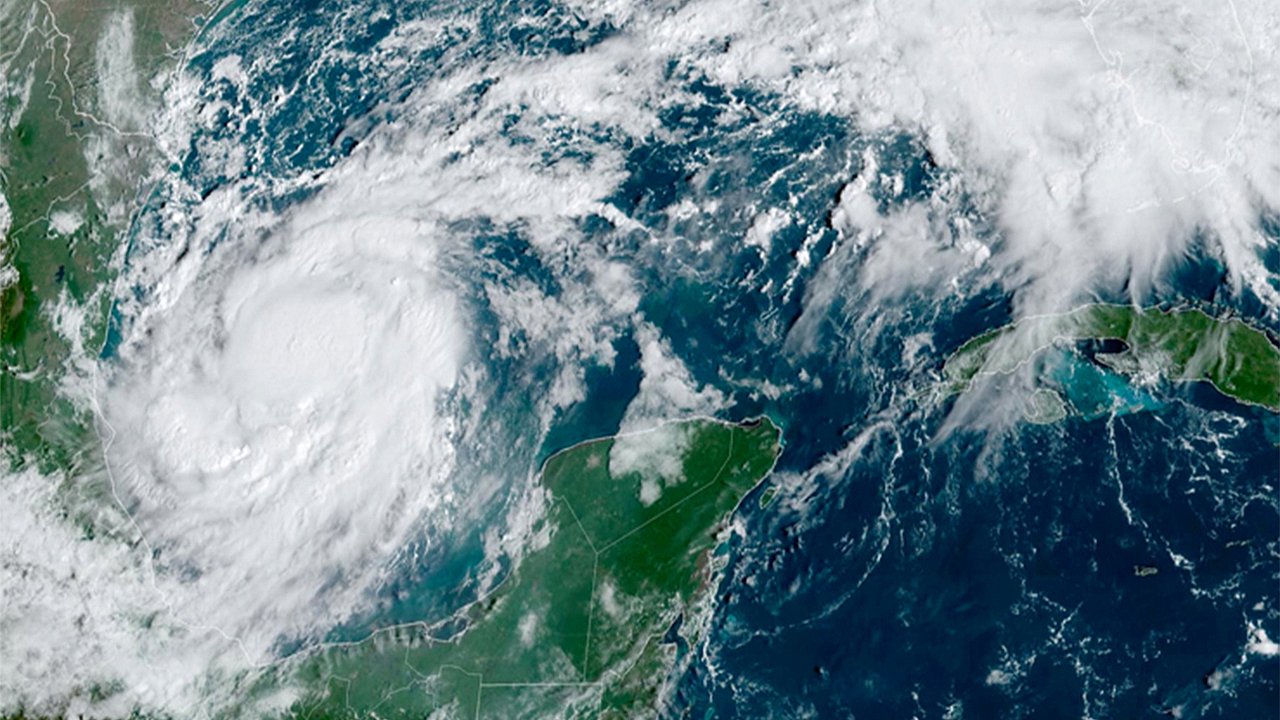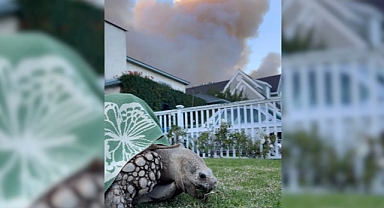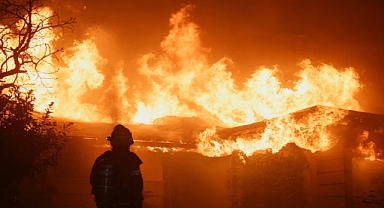Hurricane Milton, which began as a tropical storm in the Gulf of Mexico on Saturday afternoon, has quickly strengthened into a Category 1 hurricane. According to CBS News, the storm is projected to make landfall on Florida's west coast, near Tampa, by Wednesday as a Category 3 hurricane. In a Sunday evening update, meteorologists from the National Hurricane Center (NHC) reported that Milton is making its way across the central and eastern Gulf of Mexico, headed toward Florida. The hurricane is expected to take an east-northeast path on Monday, followed by a faster movement on Tuesday and Wednesday as it approaches land.
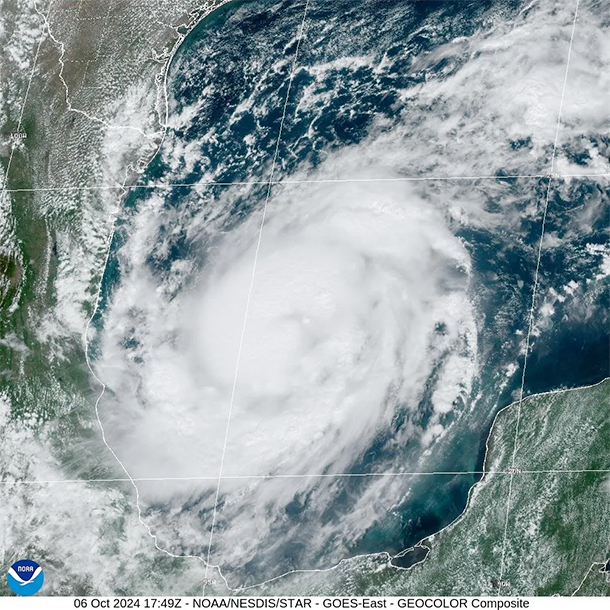 Hurricane Milton is projected to make landfall in Florida on Wednesday as a Category 3 or higher. (National Oceanic and Atmospheric Administration)Florida Prepares for ImpactFlorida Governor Ron DeSantis has announced that the state is bracing for the potential evacuation of over six million residents, as communities are still recovering from the devastation caused by Hurricane Helene just last week. Governor DeSantis has expanded the state of emergency to include 51 counties across Florida.President Joe Biden has been briefed on Hurricane Milton's possible impacts, according to the White House. The President was informed of the preparations being made by the Federal Emergency Management Agency (FEMA) to aid in the response. FEMA is already facing challenges due to the active hurricane season, and further funding may be needed to support recovery efforts.Mexico’s government has also issued a hurricane watch for the coastline between Celestún and Cabo Catoche, with a tropical storm warning extending from Celestún to Cancun. Residents of the Florida Peninsula, the Florida Keys, and the northwestern Bahamas are advised to closely monitor the storm’s progress.Hurricane Milton’s Current Path and StrengthAs of Sunday, 5 p.m. ET:Milton was approximately 275 miles west-northwest of Progreso, Mexico, and around 805 miles west-southwest of Tampa, Florida.
Hurricane Milton is projected to make landfall in Florida on Wednesday as a Category 3 or higher. (National Oceanic and Atmospheric Administration)Florida Prepares for ImpactFlorida Governor Ron DeSantis has announced that the state is bracing for the potential evacuation of over six million residents, as communities are still recovering from the devastation caused by Hurricane Helene just last week. Governor DeSantis has expanded the state of emergency to include 51 counties across Florida.President Joe Biden has been briefed on Hurricane Milton's possible impacts, according to the White House. The President was informed of the preparations being made by the Federal Emergency Management Agency (FEMA) to aid in the response. FEMA is already facing challenges due to the active hurricane season, and further funding may be needed to support recovery efforts.Mexico’s government has also issued a hurricane watch for the coastline between Celestún and Cabo Catoche, with a tropical storm warning extending from Celestún to Cancun. Residents of the Florida Peninsula, the Florida Keys, and the northwestern Bahamas are advised to closely monitor the storm’s progress.Hurricane Milton’s Current Path and StrengthAs of Sunday, 5 p.m. ET:Milton was approximately 275 miles west-northwest of Progreso, Mexico, and around 805 miles west-southwest of Tampa, Florida.
The storm’s maximum sustained winds were recorded at 85 mph.
Milton was moving eastward across the Gulf of Mexico at 7 mph.
Hurricanes are categorized based on wind speeds, with Category 1 storms featuring winds between 74 mph and 95 mph, while Category 3 storms have winds between 111 mph and 129 mph. Milton is expected to reach Category 3 status by the time it nears Florida’s coast.
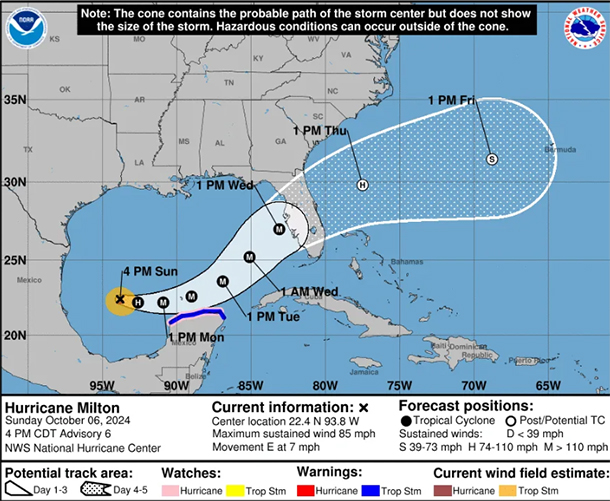 Life-Threatening Risks and Flooding ConcernsThe NHC has warned that the risk of "life-threatening impacts" is increasing for parts of Florida’s west coast. A storm surge could raise water levels by as much as 2 to 4 feet along the northern Yucatan Peninsula, with dangerous waves expected along the coast throughout the week.Residents in Florida are advised to have a hurricane preparedness plan in place as the storm approaches. Forecasters are predicting that portions of the Florida Peninsula and the Florida Keys could receive 5 to 10 inches of rain, with localized areas seeing up to 15 inches by Wednesday night. This heavy rainfall could result in significant flash flooding, urban flooding, and river flooding. Additionally, the northern Yucatan Peninsula may see rainfall of 2 to 4 inches.Hurricane Kirk and Aftermath of HeleneWhile Hurricane Milton is expected to bring significant impacts, Hurricane Kirk has weakened to a Category 2 storm and is moving north-northeast over open waters as of Sunday afternoon. No coastal watches or warnings have been issued for Kirk. Milton’s approach comes just over a week after Florida was battered by Hurricane Helene, which made landfall as a powerful Category 4 storm. Helene claimed at least 20 lives in Florida, with its 140 mph winds causing widespread destruction as it moved inland. The storm left more than 200 people dead across the Southeast. As of Sunday evening, over 350,000 utility customers in Florida were still without power due to the damage left by Helene.
Life-Threatening Risks and Flooding ConcernsThe NHC has warned that the risk of "life-threatening impacts" is increasing for parts of Florida’s west coast. A storm surge could raise water levels by as much as 2 to 4 feet along the northern Yucatan Peninsula, with dangerous waves expected along the coast throughout the week.Residents in Florida are advised to have a hurricane preparedness plan in place as the storm approaches. Forecasters are predicting that portions of the Florida Peninsula and the Florida Keys could receive 5 to 10 inches of rain, with localized areas seeing up to 15 inches by Wednesday night. This heavy rainfall could result in significant flash flooding, urban flooding, and river flooding. Additionally, the northern Yucatan Peninsula may see rainfall of 2 to 4 inches.Hurricane Kirk and Aftermath of HeleneWhile Hurricane Milton is expected to bring significant impacts, Hurricane Kirk has weakened to a Category 2 storm and is moving north-northeast over open waters as of Sunday afternoon. No coastal watches or warnings have been issued for Kirk. Milton’s approach comes just over a week after Florida was battered by Hurricane Helene, which made landfall as a powerful Category 4 storm. Helene claimed at least 20 lives in Florida, with its 140 mph winds causing widespread destruction as it moved inland. The storm left more than 200 people dead across the Southeast. As of Sunday evening, over 350,000 utility customers in Florida were still without power due to the damage left by Helene.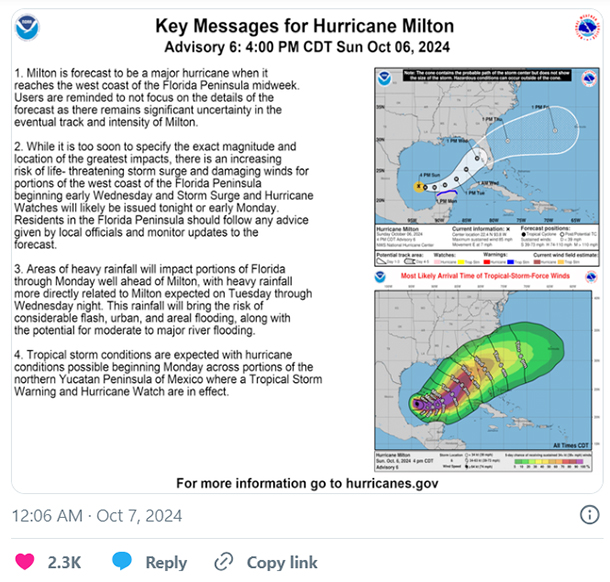 An Active Hurricane SeasonHurricane season officially runs from June 1 through November 30, but peak activity typically occurs between August and October. The National Oceanic and Atmospheric Administration (NOAA) describes a “normal” Atlantic hurricane season as having around 14 named storms, with seven becoming hurricanes and three reaching major hurricane status. As of early October, the Atlantic has seen eight hurricanes, with Milton becoming the 13th named storm of the season. According to CNN, the season is running ahead of the usual schedule, as the 13th storm typically does not form until late October.Amid this intense season, Homeland Security Secretary Alejandro Mayorkas recently warned that FEMA is running low on resources. President Biden has suggested that Congress may need to pass a supplemental spending bill to help support state recovery efforts as hurricane season continues.
An Active Hurricane SeasonHurricane season officially runs from June 1 through November 30, but peak activity typically occurs between August and October. The National Oceanic and Atmospheric Administration (NOAA) describes a “normal” Atlantic hurricane season as having around 14 named storms, with seven becoming hurricanes and three reaching major hurricane status. As of early October, the Atlantic has seen eight hurricanes, with Milton becoming the 13th named storm of the season. According to CNN, the season is running ahead of the usual schedule, as the 13th storm typically does not form until late October.Amid this intense season, Homeland Security Secretary Alejandro Mayorkas recently warned that FEMA is running low on resources. President Biden has suggested that Congress may need to pass a supplemental spending bill to help support state recovery efforts as hurricane season continues.
 Hurricane Milton is projected to make landfall in Florida on Wednesday as a Category 3 or higher. (National Oceanic and Atmospheric Administration)Florida Prepares for ImpactFlorida Governor Ron DeSantis has announced that the state is bracing for the potential evacuation of over six million residents, as communities are still recovering from the devastation caused by Hurricane Helene just last week. Governor DeSantis has expanded the state of emergency to include 51 counties across Florida.President Joe Biden has been briefed on Hurricane Milton's possible impacts, according to the White House. The President was informed of the preparations being made by the Federal Emergency Management Agency (FEMA) to aid in the response. FEMA is already facing challenges due to the active hurricane season, and further funding may be needed to support recovery efforts.Mexico’s government has also issued a hurricane watch for the coastline between Celestún and Cabo Catoche, with a tropical storm warning extending from Celestún to Cancun. Residents of the Florida Peninsula, the Florida Keys, and the northwestern Bahamas are advised to closely monitor the storm’s progress.Hurricane Milton’s Current Path and StrengthAs of Sunday, 5 p.m. ET:Milton was approximately 275 miles west-northwest of Progreso, Mexico, and around 805 miles west-southwest of Tampa, Florida.
Hurricane Milton is projected to make landfall in Florida on Wednesday as a Category 3 or higher. (National Oceanic and Atmospheric Administration)Florida Prepares for ImpactFlorida Governor Ron DeSantis has announced that the state is bracing for the potential evacuation of over six million residents, as communities are still recovering from the devastation caused by Hurricane Helene just last week. Governor DeSantis has expanded the state of emergency to include 51 counties across Florida.President Joe Biden has been briefed on Hurricane Milton's possible impacts, according to the White House. The President was informed of the preparations being made by the Federal Emergency Management Agency (FEMA) to aid in the response. FEMA is already facing challenges due to the active hurricane season, and further funding may be needed to support recovery efforts.Mexico’s government has also issued a hurricane watch for the coastline between Celestún and Cabo Catoche, with a tropical storm warning extending from Celestún to Cancun. Residents of the Florida Peninsula, the Florida Keys, and the northwestern Bahamas are advised to closely monitor the storm’s progress.Hurricane Milton’s Current Path and StrengthAs of Sunday, 5 p.m. ET:Milton was approximately 275 miles west-northwest of Progreso, Mexico, and around 805 miles west-southwest of Tampa, Florida.The storm’s maximum sustained winds were recorded at 85 mph.
Milton was moving eastward across the Gulf of Mexico at 7 mph.
Hurricanes are categorized based on wind speeds, with Category 1 storms featuring winds between 74 mph and 95 mph, while Category 3 storms have winds between 111 mph and 129 mph. Milton is expected to reach Category 3 status by the time it nears Florida’s coast.
 Life-Threatening Risks and Flooding ConcernsThe NHC has warned that the risk of "life-threatening impacts" is increasing for parts of Florida’s west coast. A storm surge could raise water levels by as much as 2 to 4 feet along the northern Yucatan Peninsula, with dangerous waves expected along the coast throughout the week.Residents in Florida are advised to have a hurricane preparedness plan in place as the storm approaches. Forecasters are predicting that portions of the Florida Peninsula and the Florida Keys could receive 5 to 10 inches of rain, with localized areas seeing up to 15 inches by Wednesday night. This heavy rainfall could result in significant flash flooding, urban flooding, and river flooding. Additionally, the northern Yucatan Peninsula may see rainfall of 2 to 4 inches.Hurricane Kirk and Aftermath of HeleneWhile Hurricane Milton is expected to bring significant impacts, Hurricane Kirk has weakened to a Category 2 storm and is moving north-northeast over open waters as of Sunday afternoon. No coastal watches or warnings have been issued for Kirk. Milton’s approach comes just over a week after Florida was battered by Hurricane Helene, which made landfall as a powerful Category 4 storm. Helene claimed at least 20 lives in Florida, with its 140 mph winds causing widespread destruction as it moved inland. The storm left more than 200 people dead across the Southeast. As of Sunday evening, over 350,000 utility customers in Florida were still without power due to the damage left by Helene.
Life-Threatening Risks and Flooding ConcernsThe NHC has warned that the risk of "life-threatening impacts" is increasing for parts of Florida’s west coast. A storm surge could raise water levels by as much as 2 to 4 feet along the northern Yucatan Peninsula, with dangerous waves expected along the coast throughout the week.Residents in Florida are advised to have a hurricane preparedness plan in place as the storm approaches. Forecasters are predicting that portions of the Florida Peninsula and the Florida Keys could receive 5 to 10 inches of rain, with localized areas seeing up to 15 inches by Wednesday night. This heavy rainfall could result in significant flash flooding, urban flooding, and river flooding. Additionally, the northern Yucatan Peninsula may see rainfall of 2 to 4 inches.Hurricane Kirk and Aftermath of HeleneWhile Hurricane Milton is expected to bring significant impacts, Hurricane Kirk has weakened to a Category 2 storm and is moving north-northeast over open waters as of Sunday afternoon. No coastal watches or warnings have been issued for Kirk. Milton’s approach comes just over a week after Florida was battered by Hurricane Helene, which made landfall as a powerful Category 4 storm. Helene claimed at least 20 lives in Florida, with its 140 mph winds causing widespread destruction as it moved inland. The storm left more than 200 people dead across the Southeast. As of Sunday evening, over 350,000 utility customers in Florida were still without power due to the damage left by Helene. An Active Hurricane SeasonHurricane season officially runs from June 1 through November 30, but peak activity typically occurs between August and October. The National Oceanic and Atmospheric Administration (NOAA) describes a “normal” Atlantic hurricane season as having around 14 named storms, with seven becoming hurricanes and three reaching major hurricane status. As of early October, the Atlantic has seen eight hurricanes, with Milton becoming the 13th named storm of the season. According to CNN, the season is running ahead of the usual schedule, as the 13th storm typically does not form until late October.Amid this intense season, Homeland Security Secretary Alejandro Mayorkas recently warned that FEMA is running low on resources. President Biden has suggested that Congress may need to pass a supplemental spending bill to help support state recovery efforts as hurricane season continues.
An Active Hurricane SeasonHurricane season officially runs from June 1 through November 30, but peak activity typically occurs between August and October. The National Oceanic and Atmospheric Administration (NOAA) describes a “normal” Atlantic hurricane season as having around 14 named storms, with seven becoming hurricanes and three reaching major hurricane status. As of early October, the Atlantic has seen eight hurricanes, with Milton becoming the 13th named storm of the season. According to CNN, the season is running ahead of the usual schedule, as the 13th storm typically does not form until late October.Amid this intense season, Homeland Security Secretary Alejandro Mayorkas recently warned that FEMA is running low on resources. President Biden has suggested that Congress may need to pass a supplemental spending bill to help support state recovery efforts as hurricane season continues.